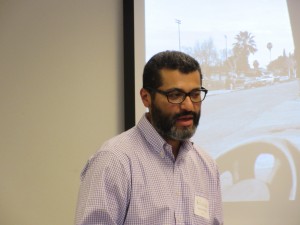Calif. ethnic media reporters lauded for covering tough subject of Common Core
SAN MATEO, California – Eight journalists from ethnic media who reported on the launch and the first tests for California’s new Common Core education standards for almost nine months were honored by the Silicon Valley Community Foundation (SVCF) and New America Media (NAM) Thursday, June 4 at the SVCF offices.
The ethnic media journalists who logged long hours interviewing parents, students, school administrators and attending school events included photo-journalist Rian Dundon, “Buenas Tardes con Celina’s” Celina Rodriguez, Cali Today’s Giang Yan Phan, East Palo Alto Today’s Henrietta Burroughs, Noticias Univision’s Melissa Hernandez , El Observador’s Veronica Anendano and this reporter, Fil Am Star’s Harvey Barkin. India West’s Lisa Tsering could not make it to the luncheon.

Radio host Celina Rodriguez was among ethnic media journalists honored for covering Common Core. PHOTOS BY HARVEY BARKIN
Common Core is a mandate for all public schools, but it is also embraced by Catholic schools in cities like San Jose. The new standards prescribe more in-depth learning and understanding of mathematics and English Language Arts through high school.
The ideal is for all course work to be standard in any school and in any state. The most significant difference from the previous standard (No Child Left Behind) is the more rigorous course work in math. One of the long-term goals is to present math as relevant and interesting, not a difficult concept best discarded after graduation. Among other things, it could make math trendy and encourage more students to take up Science, Technology, Engineering and Math (STEM) courses.
The honored journalists reported on the impressions and impacts of the transition for parents and their children who were students from third to 12th grade. They also wrote about the teachers’ and district administrator’s experiences in finding a way to teach the new standards’ imperatives. They also covered PTA and teachers’ meetings, and the Smarter Balance Tests (commonly referred to as SBAC) last month, which first assessed the accomplishments and inadequacies of the new standards.
The journalists were challenged in reporting a relevant issue that was not perceived with the same urgency as immigration reform. But many stakeholders in the standards transition are immigrants who may not have English fluency.
The task of reporting the transition fell to the ethnic press, but each group reported different perceptions and problems as a consequence of adapting to the new Standards. Often, traditions and long-held values from the old country clashed with technology and relevance. Notices or information of the standards change were often ignored, or misunderstood by parents.
Understandably, many parents and high school graduates consider the new standards as one more obstacle to get into college. Some opted to transfer to specific charter schools, be home schooled, or enroll in other alternative systems.
Rumors of a shorter duration but difficult SAT and new aggregate ACT and SAT scores for college acceptance have made parents and students anxious.
Mauricio Palma of SVCF related that “when the (John S. and James L.) Knight Foundation asked SVCF how we might engage our community, NAM had already developed a platform to bring ethnic fellows together. NAM brought the idea to SVCF. Without this collaboration and imagination, the Common Core Reporting Fellow program won’t happen.”
NAM Director Sandy Close asked ethnic media members who were guests, “What are the information gaps? What information will be needed four or five years from now? And what would your outlet do?”
El Observador Foundation Director Hilbert Morales replied, “It’s not the digital but the ignorance gap. The value of the standards is difficult to put out as infographics. We need to disseminate good information. We don’t need spin masters. Politics is only for the greedy, not the needy.”
Noticias 14 Univision’s Carolina Echeverria said that it was like “the proper dissemination of information for immigration reform solution. We must empower the teachers, the schools and their leaders like immigration lawyers were empowered.”
Siliconeer Co-founder and Editor-in-chief Amar Gupta stated, “Social media is the key.” Philippine News’ Truth Esguerra agreed and specified “Youtube” as the best tool to effectively spread the word about the Standards.
Oakland-based Rian Dundon showed some slides of where the reporting fellows did their work: William C. Overfelt High School in San Jose, Atascadero High School, Design Tech High School in Millbrae and San Mateo County Education.
The reporting fellows concluded their contracts by submitting four stories. Story treatments included print, digital, broadcast and radio. A website landing page collected these stories as news feeds to both ethnic and mainstream news outlets about Common Core Standards. The site is at https://newamericamedia.org/news/education/common-core-in-silicon-valley/index.php
Like us on Facebook

